Leadership and Terrorism in India
VerifiedAdded on 2023/06/05
|16
|4753
|465
AI Summary
This essay discusses the major wicked problem of India, terrorism, and the leadership issues that contribute to it. The suitable leadership approaches and frameworks are evaluated to resolve the issue of terrorism in India. The discussion includes the major forms of terrorism in India, critical leadership issues, and the role of different leaderships in resolving the problem. The recommended leadership approach is the group or functional approach, and various recommendations are provided to revolutionize terrorism in India.
Contribute Materials
Your contribution can guide someone’s learning journey. Share your
documents today.
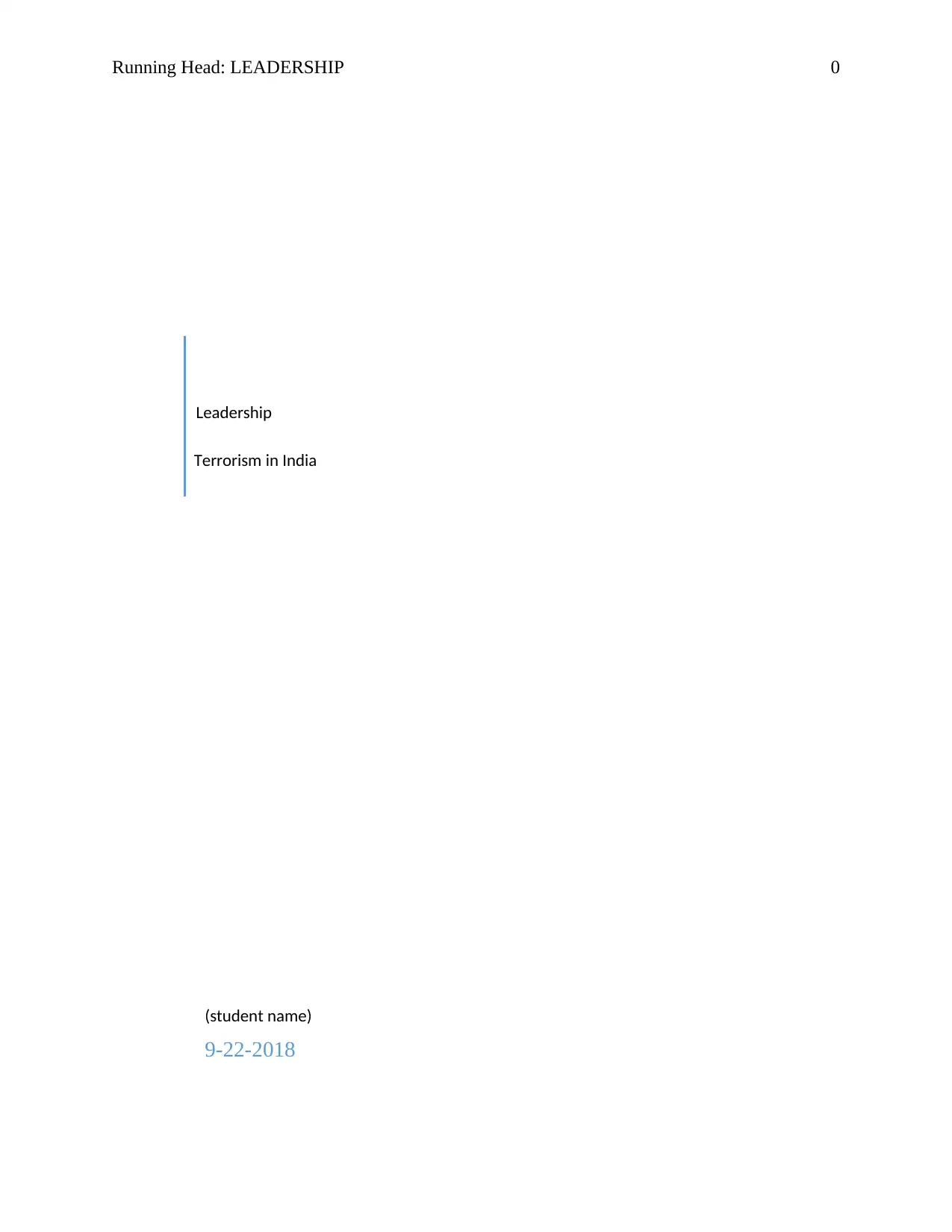
Running Head: LEADERSHIP 0
Leadership
Terrorism in India
(student name)
9-22-2018
Leadership
Terrorism in India
(student name)
9-22-2018
Secure Best Marks with AI Grader
Need help grading? Try our AI Grader for instant feedback on your assignments.
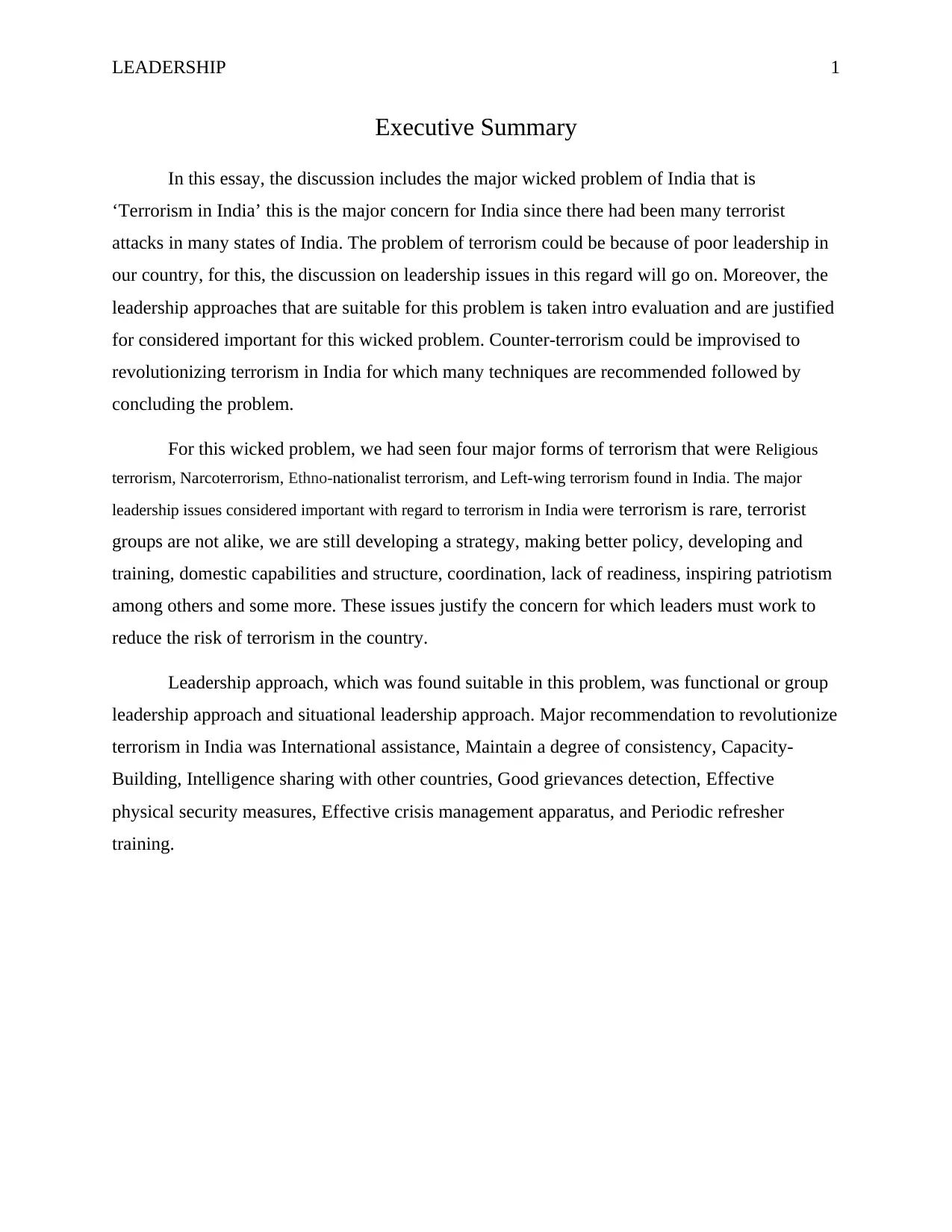
LEADERSHIP 1
Executive Summary
In this essay, the discussion includes the major wicked problem of India that is
‘Terrorism in India’ this is the major concern for India since there had been many terrorist
attacks in many states of India. The problem of terrorism could be because of poor leadership in
our country, for this, the discussion on leadership issues in this regard will go on. Moreover, the
leadership approaches that are suitable for this problem is taken intro evaluation and are justified
for considered important for this wicked problem. Counter-terrorism could be improvised to
revolutionizing terrorism in India for which many techniques are recommended followed by
concluding the problem.
For this wicked problem, we had seen four major forms of terrorism that were Religious
terrorism, Narcoterrorism, Ethno-nationalist terrorism, and Left-wing terrorism found in India. The major
leadership issues considered important with regard to terrorism in India were terrorism is rare, terrorist
groups are not alike, we are still developing a strategy, making better policy, developing and
training, domestic capabilities and structure, coordination, lack of readiness, inspiring patriotism
among others and some more. These issues justify the concern for which leaders must work to
reduce the risk of terrorism in the country.
Leadership approach, which was found suitable in this problem, was functional or group
leadership approach and situational leadership approach. Major recommendation to revolutionize
terrorism in India was International assistance, Maintain a degree of consistency, Capacity-
Building, Intelligence sharing with other countries, Good grievances detection, Effective
physical security measures, Effective crisis management apparatus, and Periodic refresher
training.
Executive Summary
In this essay, the discussion includes the major wicked problem of India that is
‘Terrorism in India’ this is the major concern for India since there had been many terrorist
attacks in many states of India. The problem of terrorism could be because of poor leadership in
our country, for this, the discussion on leadership issues in this regard will go on. Moreover, the
leadership approaches that are suitable for this problem is taken intro evaluation and are justified
for considered important for this wicked problem. Counter-terrorism could be improvised to
revolutionizing terrorism in India for which many techniques are recommended followed by
concluding the problem.
For this wicked problem, we had seen four major forms of terrorism that were Religious
terrorism, Narcoterrorism, Ethno-nationalist terrorism, and Left-wing terrorism found in India. The major
leadership issues considered important with regard to terrorism in India were terrorism is rare, terrorist
groups are not alike, we are still developing a strategy, making better policy, developing and
training, domestic capabilities and structure, coordination, lack of readiness, inspiring patriotism
among others and some more. These issues justify the concern for which leaders must work to
reduce the risk of terrorism in the country.
Leadership approach, which was found suitable in this problem, was functional or group
leadership approach and situational leadership approach. Major recommendation to revolutionize
terrorism in India was International assistance, Maintain a degree of consistency, Capacity-
Building, Intelligence sharing with other countries, Good grievances detection, Effective
physical security measures, Effective crisis management apparatus, and Periodic refresher
training.
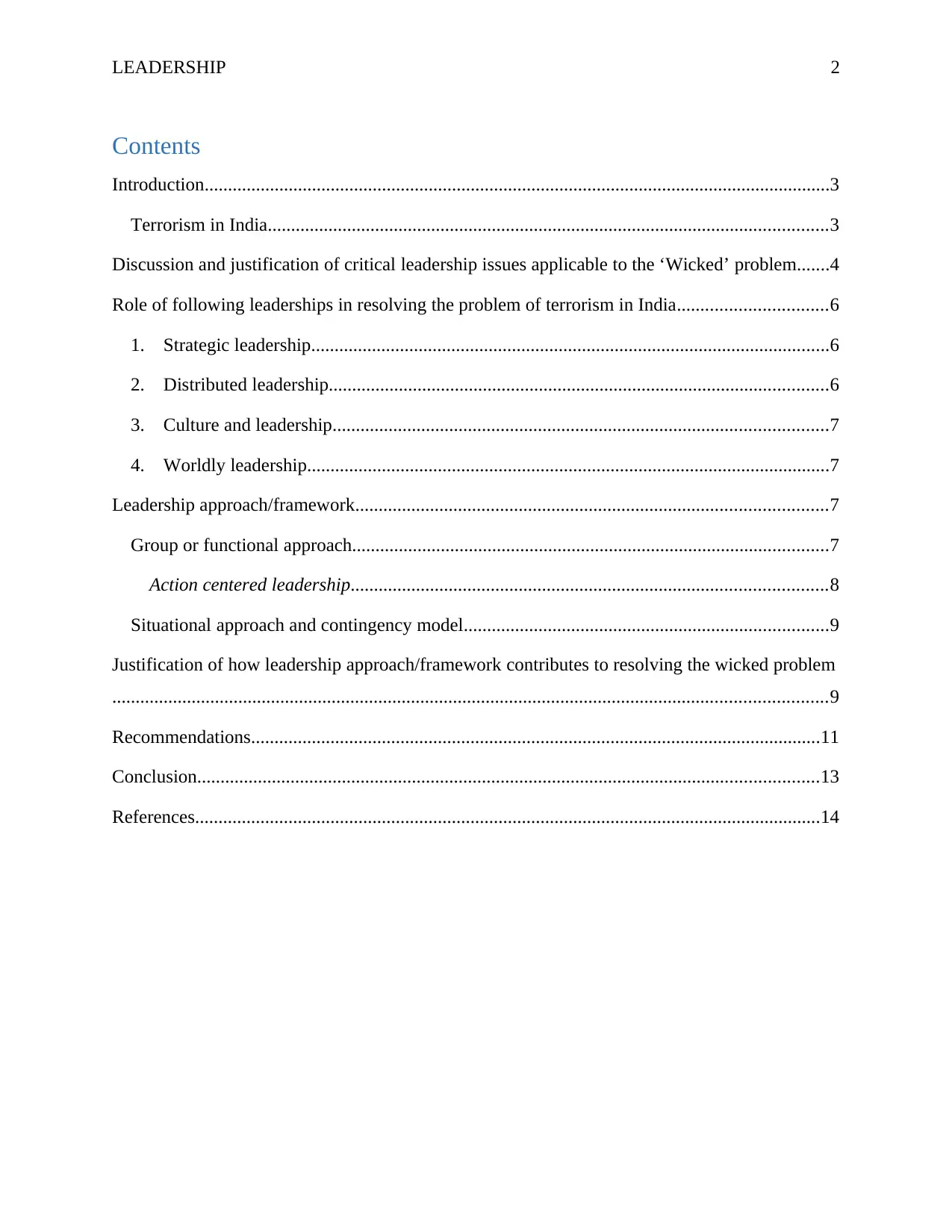
LEADERSHIP 2
Contents
Introduction......................................................................................................................................3
Terrorism in India........................................................................................................................3
Discussion and justification of critical leadership issues applicable to the ‘Wicked’ problem.......4
Role of following leaderships in resolving the problem of terrorism in India................................6
1. Strategic leadership...............................................................................................................6
2. Distributed leadership...........................................................................................................6
3. Culture and leadership..........................................................................................................7
4. Worldly leadership................................................................................................................7
Leadership approach/framework.....................................................................................................7
Group or functional approach......................................................................................................7
Action centered leadership......................................................................................................8
Situational approach and contingency model..............................................................................9
Justification of how leadership approach/framework contributes to resolving the wicked problem
.........................................................................................................................................................9
Recommendations..........................................................................................................................11
Conclusion.....................................................................................................................................13
References......................................................................................................................................14
Contents
Introduction......................................................................................................................................3
Terrorism in India........................................................................................................................3
Discussion and justification of critical leadership issues applicable to the ‘Wicked’ problem.......4
Role of following leaderships in resolving the problem of terrorism in India................................6
1. Strategic leadership...............................................................................................................6
2. Distributed leadership...........................................................................................................6
3. Culture and leadership..........................................................................................................7
4. Worldly leadership................................................................................................................7
Leadership approach/framework.....................................................................................................7
Group or functional approach......................................................................................................7
Action centered leadership......................................................................................................8
Situational approach and contingency model..............................................................................9
Justification of how leadership approach/framework contributes to resolving the wicked problem
.........................................................................................................................................................9
Recommendations..........................................................................................................................11
Conclusion.....................................................................................................................................13
References......................................................................................................................................14
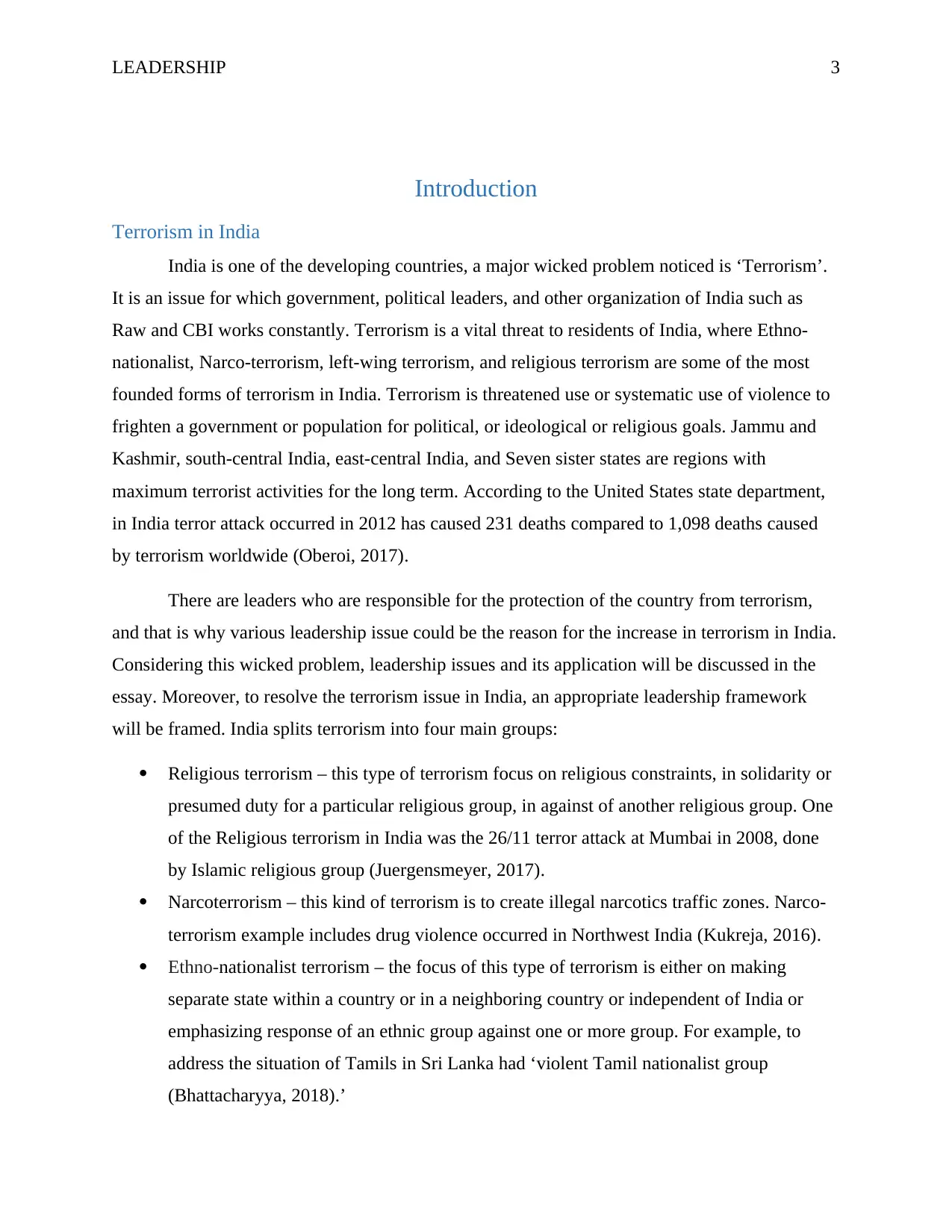
LEADERSHIP 3
Introduction
Terrorism in India
India is one of the developing countries, a major wicked problem noticed is ‘Terrorism’.
It is an issue for which government, political leaders, and other organization of India such as
Raw and CBI works constantly. Terrorism is a vital threat to residents of India, where Ethno-
nationalist, Narco-terrorism, left-wing terrorism, and religious terrorism are some of the most
founded forms of terrorism in India. Terrorism is threatened use or systematic use of violence to
frighten a government or population for political, or ideological or religious goals. Jammu and
Kashmir, south-central India, east-central India, and Seven sister states are regions with
maximum terrorist activities for the long term. According to the United States state department,
in India terror attack occurred in 2012 has caused 231 deaths compared to 1,098 deaths caused
by terrorism worldwide (Oberoi, 2017).
There are leaders who are responsible for the protection of the country from terrorism,
and that is why various leadership issue could be the reason for the increase in terrorism in India.
Considering this wicked problem, leadership issues and its application will be discussed in the
essay. Moreover, to resolve the terrorism issue in India, an appropriate leadership framework
will be framed. India splits terrorism into four main groups:
Religious terrorism – this type of terrorism focus on religious constraints, in solidarity or
presumed duty for a particular religious group, in against of another religious group. One
of the Religious terrorism in India was the 26/11 terror attack at Mumbai in 2008, done
by Islamic religious group (Juergensmeyer, 2017).
Narcoterrorism – this kind of terrorism is to create illegal narcotics traffic zones. Narco-
terrorism example includes drug violence occurred in Northwest India (Kukreja, 2016).
Ethno-nationalist terrorism – the focus of this type of terrorism is either on making
separate state within a country or in a neighboring country or independent of India or
emphasizing response of an ethnic group against one or more group. For example, to
address the situation of Tamils in Sri Lanka had ‘violent Tamil nationalist group
(Bhattacharyya, 2018).’
Introduction
Terrorism in India
India is one of the developing countries, a major wicked problem noticed is ‘Terrorism’.
It is an issue for which government, political leaders, and other organization of India such as
Raw and CBI works constantly. Terrorism is a vital threat to residents of India, where Ethno-
nationalist, Narco-terrorism, left-wing terrorism, and religious terrorism are some of the most
founded forms of terrorism in India. Terrorism is threatened use or systematic use of violence to
frighten a government or population for political, or ideological or religious goals. Jammu and
Kashmir, south-central India, east-central India, and Seven sister states are regions with
maximum terrorist activities for the long term. According to the United States state department,
in India terror attack occurred in 2012 has caused 231 deaths compared to 1,098 deaths caused
by terrorism worldwide (Oberoi, 2017).
There are leaders who are responsible for the protection of the country from terrorism,
and that is why various leadership issue could be the reason for the increase in terrorism in India.
Considering this wicked problem, leadership issues and its application will be discussed in the
essay. Moreover, to resolve the terrorism issue in India, an appropriate leadership framework
will be framed. India splits terrorism into four main groups:
Religious terrorism – this type of terrorism focus on religious constraints, in solidarity or
presumed duty for a particular religious group, in against of another religious group. One
of the Religious terrorism in India was the 26/11 terror attack at Mumbai in 2008, done
by Islamic religious group (Juergensmeyer, 2017).
Narcoterrorism – this kind of terrorism is to create illegal narcotics traffic zones. Narco-
terrorism example includes drug violence occurred in Northwest India (Kukreja, 2016).
Ethno-nationalist terrorism – the focus of this type of terrorism is either on making
separate state within a country or in a neighboring country or independent of India or
emphasizing response of an ethnic group against one or more group. For example, to
address the situation of Tamils in Sri Lanka had ‘violent Tamil nationalist group
(Bhattacharyya, 2018).’
Secure Best Marks with AI Grader
Need help grading? Try our AI Grader for instant feedback on your assignments.
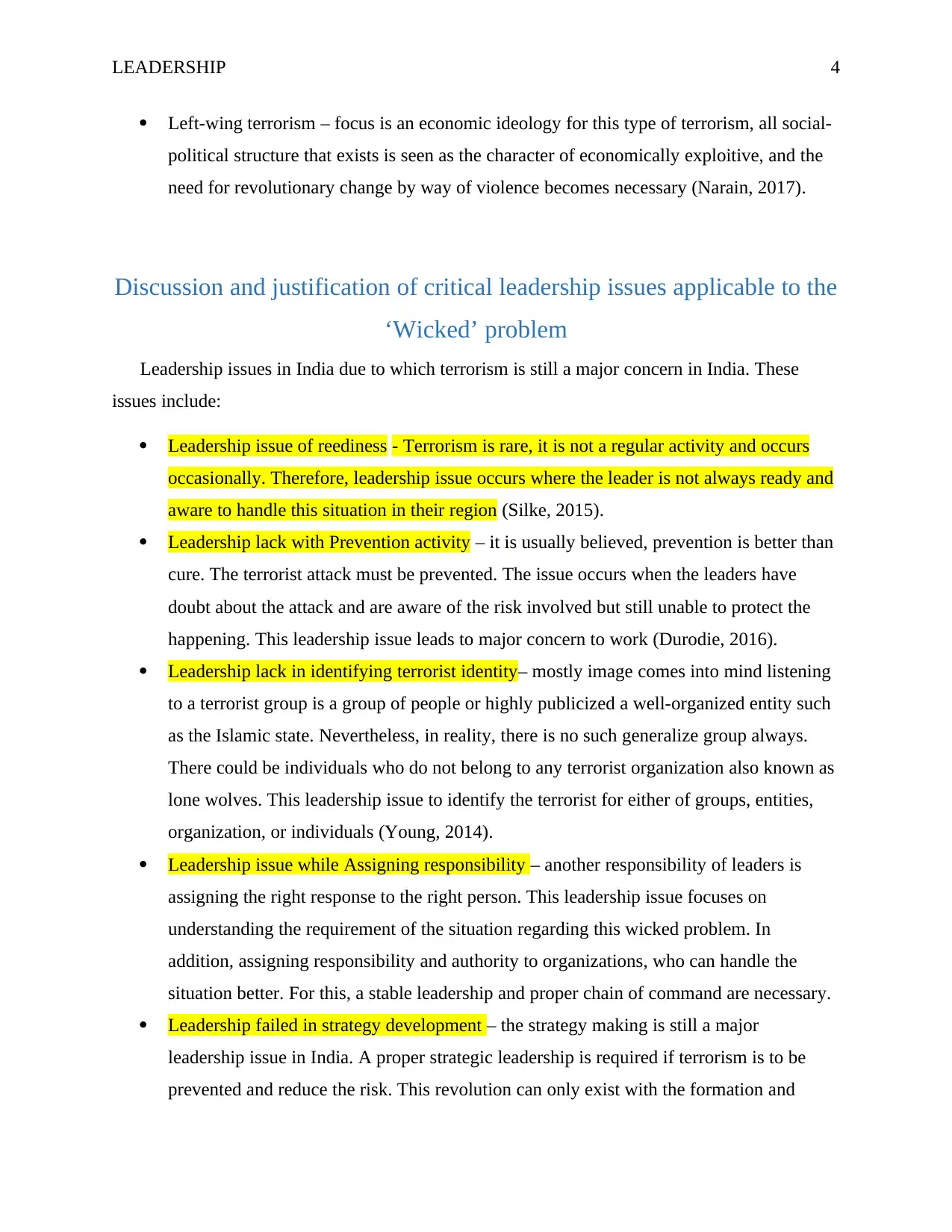
LEADERSHIP 4
Left-wing terrorism – focus is an economic ideology for this type of terrorism, all social-
political structure that exists is seen as the character of economically exploitive, and the
need for revolutionary change by way of violence becomes necessary (Narain, 2017).
Discussion and justification of critical leadership issues applicable to the
‘Wicked’ problem
Leadership issues in India due to which terrorism is still a major concern in India. These
issues include:
Leadership issue of reediness - Terrorism is rare, it is not a regular activity and occurs
occasionally. Therefore, leadership issue occurs where the leader is not always ready and
aware to handle this situation in their region (Silke, 2015).
Leadership lack with Prevention activity – it is usually believed, prevention is better than
cure. The terrorist attack must be prevented. The issue occurs when the leaders have
doubt about the attack and are aware of the risk involved but still unable to protect the
happening. This leadership issue leads to major concern to work (Durodie, 2016).
Leadership lack in identifying terrorist identity– mostly image comes into mind listening
to a terrorist group is a group of people or highly publicized a well-organized entity such
as the Islamic state. Nevertheless, in reality, there is no such generalize group always.
There could be individuals who do not belong to any terrorist organization also known as
lone wolves. This leadership issue to identify the terrorist for either of groups, entities,
organization, or individuals (Young, 2014).
Leadership issue while Assigning responsibility – another responsibility of leaders is
assigning the right response to the right person. This leadership issue focuses on
understanding the requirement of the situation regarding this wicked problem. In
addition, assigning responsibility and authority to organizations, who can handle the
situation better. For this, a stable leadership and proper chain of command are necessary.
Leadership failed in strategy development – the strategy making is still a major
leadership issue in India. A proper strategic leadership is required if terrorism is to be
prevented and reduce the risk. This revolution can only exist with the formation and
Left-wing terrorism – focus is an economic ideology for this type of terrorism, all social-
political structure that exists is seen as the character of economically exploitive, and the
need for revolutionary change by way of violence becomes necessary (Narain, 2017).
Discussion and justification of critical leadership issues applicable to the
‘Wicked’ problem
Leadership issues in India due to which terrorism is still a major concern in India. These
issues include:
Leadership issue of reediness - Terrorism is rare, it is not a regular activity and occurs
occasionally. Therefore, leadership issue occurs where the leader is not always ready and
aware to handle this situation in their region (Silke, 2015).
Leadership lack with Prevention activity – it is usually believed, prevention is better than
cure. The terrorist attack must be prevented. The issue occurs when the leaders have
doubt about the attack and are aware of the risk involved but still unable to protect the
happening. This leadership issue leads to major concern to work (Durodie, 2016).
Leadership lack in identifying terrorist identity– mostly image comes into mind listening
to a terrorist group is a group of people or highly publicized a well-organized entity such
as the Islamic state. Nevertheless, in reality, there is no such generalize group always.
There could be individuals who do not belong to any terrorist organization also known as
lone wolves. This leadership issue to identify the terrorist for either of groups, entities,
organization, or individuals (Young, 2014).
Leadership issue while Assigning responsibility – another responsibility of leaders is
assigning the right response to the right person. This leadership issue focuses on
understanding the requirement of the situation regarding this wicked problem. In
addition, assigning responsibility and authority to organizations, who can handle the
situation better. For this, a stable leadership and proper chain of command are necessary.
Leadership failed in strategy development – the strategy making is still a major
leadership issue in India. A proper strategic leadership is required if terrorism is to be
prevented and reduce the risk. This revolution can only exist with the formation and
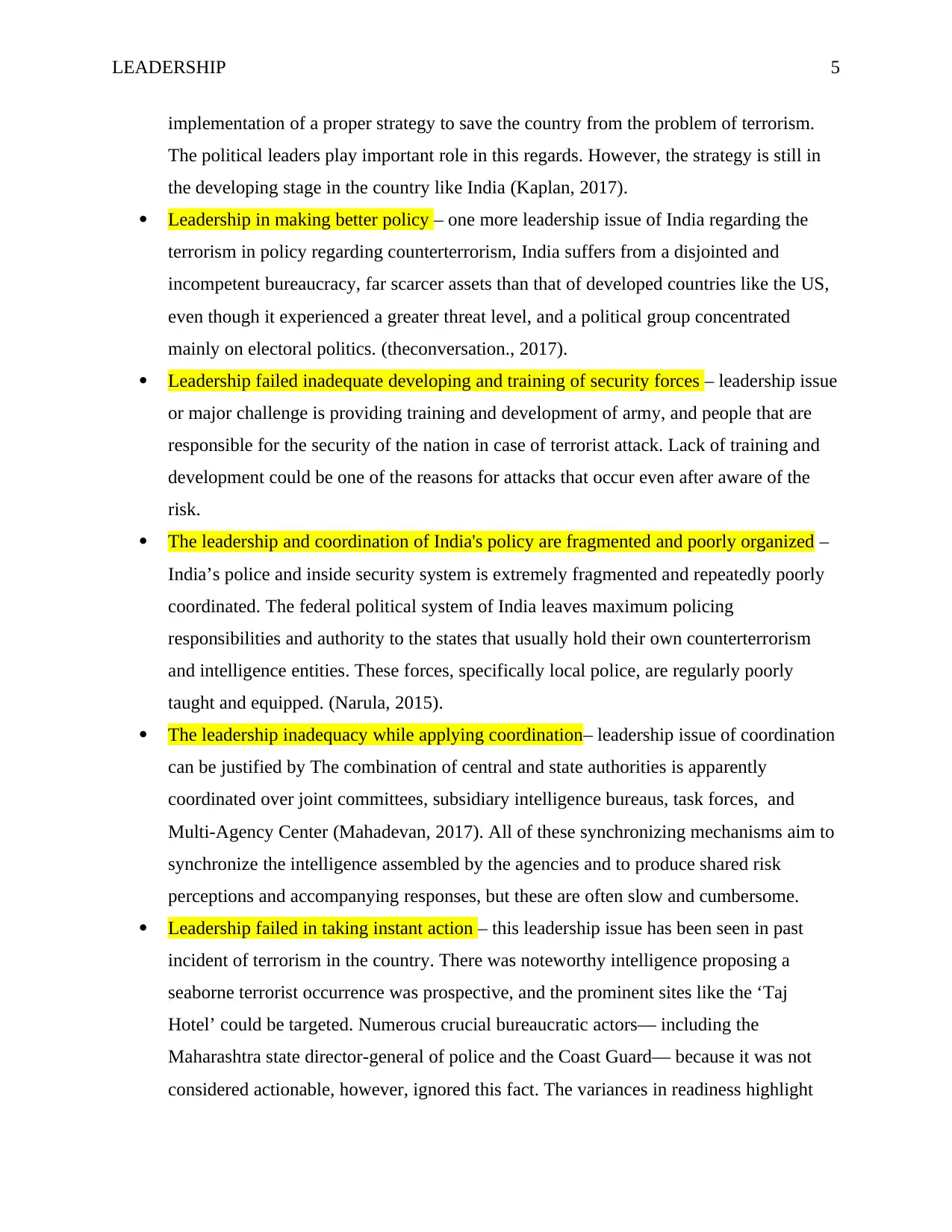
LEADERSHIP 5
implementation of a proper strategy to save the country from the problem of terrorism.
The political leaders play important role in this regards. However, the strategy is still in
the developing stage in the country like India (Kaplan, 2017).
Leadership in making better policy – one more leadership issue of India regarding the
terrorism in policy regarding counterterrorism, India suffers from a disjointed and
incompetent bureaucracy, far scarcer assets than that of developed countries like the US,
even though it experienced a greater threat level, and a political group concentrated
mainly on electoral politics. (theconversation., 2017).
Leadership failed inadequate developing and training of security forces – leadership issue
or major challenge is providing training and development of army, and people that are
responsible for the security of the nation in case of terrorist attack. Lack of training and
development could be one of the reasons for attacks that occur even after aware of the
risk.
The leadership and coordination of India's policy are fragmented and poorly organized –
India’s police and inside security system is extremely fragmented and repeatedly poorly
coordinated. The federal political system of India leaves maximum policing
responsibilities and authority to the states that usually hold their own counterterrorism
and intelligence entities. These forces, specifically local police, are regularly poorly
taught and equipped. (Narula, 2015).
The leadership inadequacy while applying coordination– leadership issue of coordination
can be justified by The combination of central and state authorities is apparently
coordinated over joint committees, subsidiary intelligence bureaus, task forces, and
Multi-Agency Center (Mahadevan, 2017). All of these synchronizing mechanisms aim to
synchronize the intelligence assembled by the agencies and to produce shared risk
perceptions and accompanying responses, but these are often slow and cumbersome.
Leadership failed in taking instant action – this leadership issue has been seen in past
incident of terrorism in the country. There was noteworthy intelligence proposing a
seaborne terrorist occurrence was prospective, and the prominent sites like the ‘Taj
Hotel’ could be targeted. Numerous crucial bureaucratic actors— including the
Maharashtra state director-general of police and the Coast Guard— because it was not
considered actionable, however, ignored this fact. The variances in readiness highlight
implementation of a proper strategy to save the country from the problem of terrorism.
The political leaders play important role in this regards. However, the strategy is still in
the developing stage in the country like India (Kaplan, 2017).
Leadership in making better policy – one more leadership issue of India regarding the
terrorism in policy regarding counterterrorism, India suffers from a disjointed and
incompetent bureaucracy, far scarcer assets than that of developed countries like the US,
even though it experienced a greater threat level, and a political group concentrated
mainly on electoral politics. (theconversation., 2017).
Leadership failed inadequate developing and training of security forces – leadership issue
or major challenge is providing training and development of army, and people that are
responsible for the security of the nation in case of terrorist attack. Lack of training and
development could be one of the reasons for attacks that occur even after aware of the
risk.
The leadership and coordination of India's policy are fragmented and poorly organized –
India’s police and inside security system is extremely fragmented and repeatedly poorly
coordinated. The federal political system of India leaves maximum policing
responsibilities and authority to the states that usually hold their own counterterrorism
and intelligence entities. These forces, specifically local police, are regularly poorly
taught and equipped. (Narula, 2015).
The leadership inadequacy while applying coordination– leadership issue of coordination
can be justified by The combination of central and state authorities is apparently
coordinated over joint committees, subsidiary intelligence bureaus, task forces, and
Multi-Agency Center (Mahadevan, 2017). All of these synchronizing mechanisms aim to
synchronize the intelligence assembled by the agencies and to produce shared risk
perceptions and accompanying responses, but these are often slow and cumbersome.
Leadership failed in taking instant action – this leadership issue has been seen in past
incident of terrorism in the country. There was noteworthy intelligence proposing a
seaborne terrorist occurrence was prospective, and the prominent sites like the ‘Taj
Hotel’ could be targeted. Numerous crucial bureaucratic actors— including the
Maharashtra state director-general of police and the Coast Guard— because it was not
considered actionable, however, ignored this fact. The variances in readiness highlight

LEADERSHIP 6
the degree of fragmentation amongst the security tool. Even after Mumbai police try to
take preventive action, they were deficient in the workforce to withstand improved
security at the hotel. After the attack occurred, the refuge forces lack sufficient heavy
weaponry, night-vision tools, or information regarding attack sites, prominent to a
elongated response time, and the emergence of a dreadful obstruction (Paul, 2009).
Leadership failure in Inspiring patriotism among others – it is the responsibility of the
leader to motivate and inspire people to enhance patriotism for their country to prevent
and reduce the risk of people involving in terrorist groups, organization and is not
influenced by the negativity of terrorists. This activity is very rare in India. People are
more influenced by the people in favor of terrorism and violence instead of against such
an act. The pitfalls and poor efficiency of this effect must be informed to people (Paul,
2009).
Role of following leaderships in resolving the problem of terrorism in
India
1. Strategic leadership – it is an ability to motivate others to, willingly make decisions for
long-term success. Tools and skills are needed to formulate and effectively implement the
strategy. This leadership will counter the issue of strategy development. The counter-
terrorism strategies made to resolve the problem of terrorism play a vital role. Some of
these strategies are ‘The state police and its intelligence set-up; The national intelligence
community; Physical security agencies; Paramilitary forces’ (rediff, 2009)
2. Distributed leadership – it is an analytical approach to understand the working of
leadership that took place among people. Instead of concerning on individual leader
characteristic or feature of situations, this type of leadership foregrounds the engagement
of personnel in a task that is distributed or stretched across the nation. Distributed
leadership can be used in equating with many designated leaders, or ideas like
collaborative, democratic, or shared leadership. Since, many political leaders and
organizations direct terrorism in India, this type of leadership would be best suited to
adopt. This leadership could be used to carter the leadership issue of “leadership and
coordination of India's police.” The collaboration was the main issue that was discussed
the degree of fragmentation amongst the security tool. Even after Mumbai police try to
take preventive action, they were deficient in the workforce to withstand improved
security at the hotel. After the attack occurred, the refuge forces lack sufficient heavy
weaponry, night-vision tools, or information regarding attack sites, prominent to a
elongated response time, and the emergence of a dreadful obstruction (Paul, 2009).
Leadership failure in Inspiring patriotism among others – it is the responsibility of the
leader to motivate and inspire people to enhance patriotism for their country to prevent
and reduce the risk of people involving in terrorist groups, organization and is not
influenced by the negativity of terrorists. This activity is very rare in India. People are
more influenced by the people in favor of terrorism and violence instead of against such
an act. The pitfalls and poor efficiency of this effect must be informed to people (Paul,
2009).
Role of following leaderships in resolving the problem of terrorism in
India
1. Strategic leadership – it is an ability to motivate others to, willingly make decisions for
long-term success. Tools and skills are needed to formulate and effectively implement the
strategy. This leadership will counter the issue of strategy development. The counter-
terrorism strategies made to resolve the problem of terrorism play a vital role. Some of
these strategies are ‘The state police and its intelligence set-up; The national intelligence
community; Physical security agencies; Paramilitary forces’ (rediff, 2009)
2. Distributed leadership – it is an analytical approach to understand the working of
leadership that took place among people. Instead of concerning on individual leader
characteristic or feature of situations, this type of leadership foregrounds the engagement
of personnel in a task that is distributed or stretched across the nation. Distributed
leadership can be used in equating with many designated leaders, or ideas like
collaborative, democratic, or shared leadership. Since, many political leaders and
organizations direct terrorism in India, this type of leadership would be best suited to
adopt. This leadership could be used to carter the leadership issue of “leadership and
coordination of India's police.” The collaboration was the main issue that was discussed
Paraphrase This Document
Need a fresh take? Get an instant paraphrase of this document with our AI Paraphraser
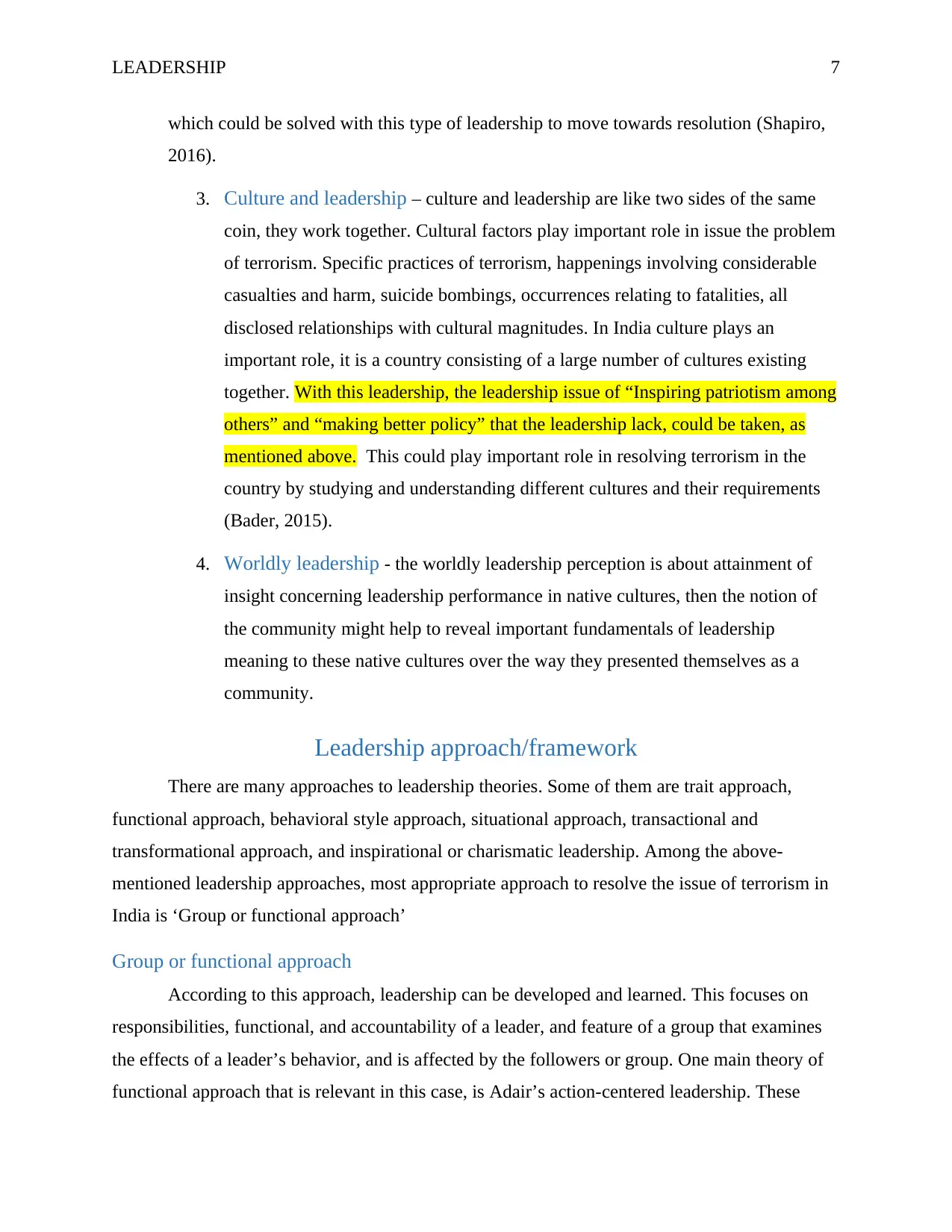
LEADERSHIP 7
which could be solved with this type of leadership to move towards resolution (Shapiro,
2016).
3. Culture and leadership – culture and leadership are like two sides of the same
coin, they work together. Cultural factors play important role in issue the problem
of terrorism. Specific practices of terrorism, happenings involving considerable
casualties and harm, suicide bombings, occurrences relating to fatalities, all
disclosed relationships with cultural magnitudes. In India culture plays an
important role, it is a country consisting of a large number of cultures existing
together. With this leadership, the leadership issue of “Inspiring patriotism among
others” and “making better policy” that the leadership lack, could be taken, as
mentioned above. This could play important role in resolving terrorism in the
country by studying and understanding different cultures and their requirements
(Bader, 2015).
4. Worldly leadership - the worldly leadership perception is about attainment of
insight concerning leadership performance in native cultures, then the notion of
the community might help to reveal important fundamentals of leadership
meaning to these native cultures over the way they presented themselves as a
community.
Leadership approach/framework
There are many approaches to leadership theories. Some of them are trait approach,
functional approach, behavioral style approach, situational approach, transactional and
transformational approach, and inspirational or charismatic leadership. Among the above-
mentioned leadership approaches, most appropriate approach to resolve the issue of terrorism in
India is ‘Group or functional approach’
Group or functional approach
According to this approach, leadership can be developed and learned. This focuses on
responsibilities, functional, and accountability of a leader, and feature of a group that examines
the effects of a leader’s behavior, and is affected by the followers or group. One main theory of
functional approach that is relevant in this case, is Adair’s action-centered leadership. These
which could be solved with this type of leadership to move towards resolution (Shapiro,
2016).
3. Culture and leadership – culture and leadership are like two sides of the same
coin, they work together. Cultural factors play important role in issue the problem
of terrorism. Specific practices of terrorism, happenings involving considerable
casualties and harm, suicide bombings, occurrences relating to fatalities, all
disclosed relationships with cultural magnitudes. In India culture plays an
important role, it is a country consisting of a large number of cultures existing
together. With this leadership, the leadership issue of “Inspiring patriotism among
others” and “making better policy” that the leadership lack, could be taken, as
mentioned above. This could play important role in resolving terrorism in the
country by studying and understanding different cultures and their requirements
(Bader, 2015).
4. Worldly leadership - the worldly leadership perception is about attainment of
insight concerning leadership performance in native cultures, then the notion of
the community might help to reveal important fundamentals of leadership
meaning to these native cultures over the way they presented themselves as a
community.
Leadership approach/framework
There are many approaches to leadership theories. Some of them are trait approach,
functional approach, behavioral style approach, situational approach, transactional and
transformational approach, and inspirational or charismatic leadership. Among the above-
mentioned leadership approaches, most appropriate approach to resolve the issue of terrorism in
India is ‘Group or functional approach’
Group or functional approach
According to this approach, leadership can be developed and learned. This focuses on
responsibilities, functional, and accountability of a leader, and feature of a group that examines
the effects of a leader’s behavior, and is affected by the followers or group. One main theory of
functional approach that is relevant in this case, is Adair’s action-centered leadership. These
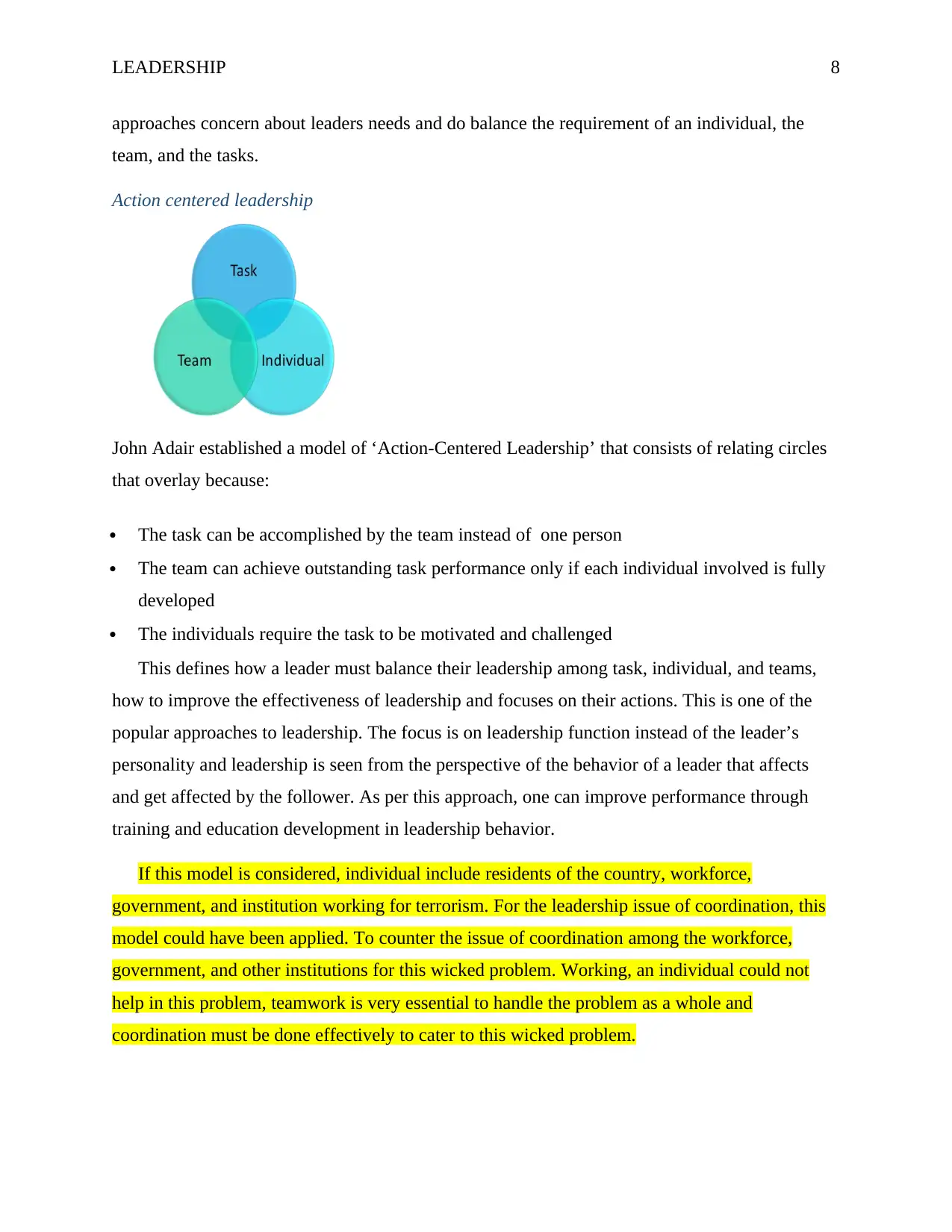
LEADERSHIP 8
approaches concern about leaders needs and do balance the requirement of an individual, the
team, and the tasks.
Action centered leadership
John Adair established a model of ‘Action-Centered Leadership’ that consists of relating circles
that overlay because:
The task can be accomplished by the team instead of one person
The team can achieve outstanding task performance only if each individual involved is fully
developed
The individuals require the task to be motivated and challenged
This defines how a leader must balance their leadership among task, individual, and teams,
how to improve the effectiveness of leadership and focuses on their actions. This is one of the
popular approaches to leadership. The focus is on leadership function instead of the leader’s
personality and leadership is seen from the perspective of the behavior of a leader that affects
and get affected by the follower. As per this approach, one can improve performance through
training and education development in leadership behavior.
If this model is considered, individual include residents of the country, workforce,
government, and institution working for terrorism. For the leadership issue of coordination, this
model could have been applied. To counter the issue of coordination among the workforce,
government, and other institutions for this wicked problem. Working, an individual could not
help in this problem, teamwork is very essential to handle the problem as a whole and
coordination must be done effectively to cater to this wicked problem.
approaches concern about leaders needs and do balance the requirement of an individual, the
team, and the tasks.
Action centered leadership
John Adair established a model of ‘Action-Centered Leadership’ that consists of relating circles
that overlay because:
The task can be accomplished by the team instead of one person
The team can achieve outstanding task performance only if each individual involved is fully
developed
The individuals require the task to be motivated and challenged
This defines how a leader must balance their leadership among task, individual, and teams,
how to improve the effectiveness of leadership and focuses on their actions. This is one of the
popular approaches to leadership. The focus is on leadership function instead of the leader’s
personality and leadership is seen from the perspective of the behavior of a leader that affects
and get affected by the follower. As per this approach, one can improve performance through
training and education development in leadership behavior.
If this model is considered, individual include residents of the country, workforce,
government, and institution working for terrorism. For the leadership issue of coordination, this
model could have been applied. To counter the issue of coordination among the workforce,
government, and other institutions for this wicked problem. Working, an individual could not
help in this problem, teamwork is very essential to handle the problem as a whole and
coordination must be done effectively to cater to this wicked problem.
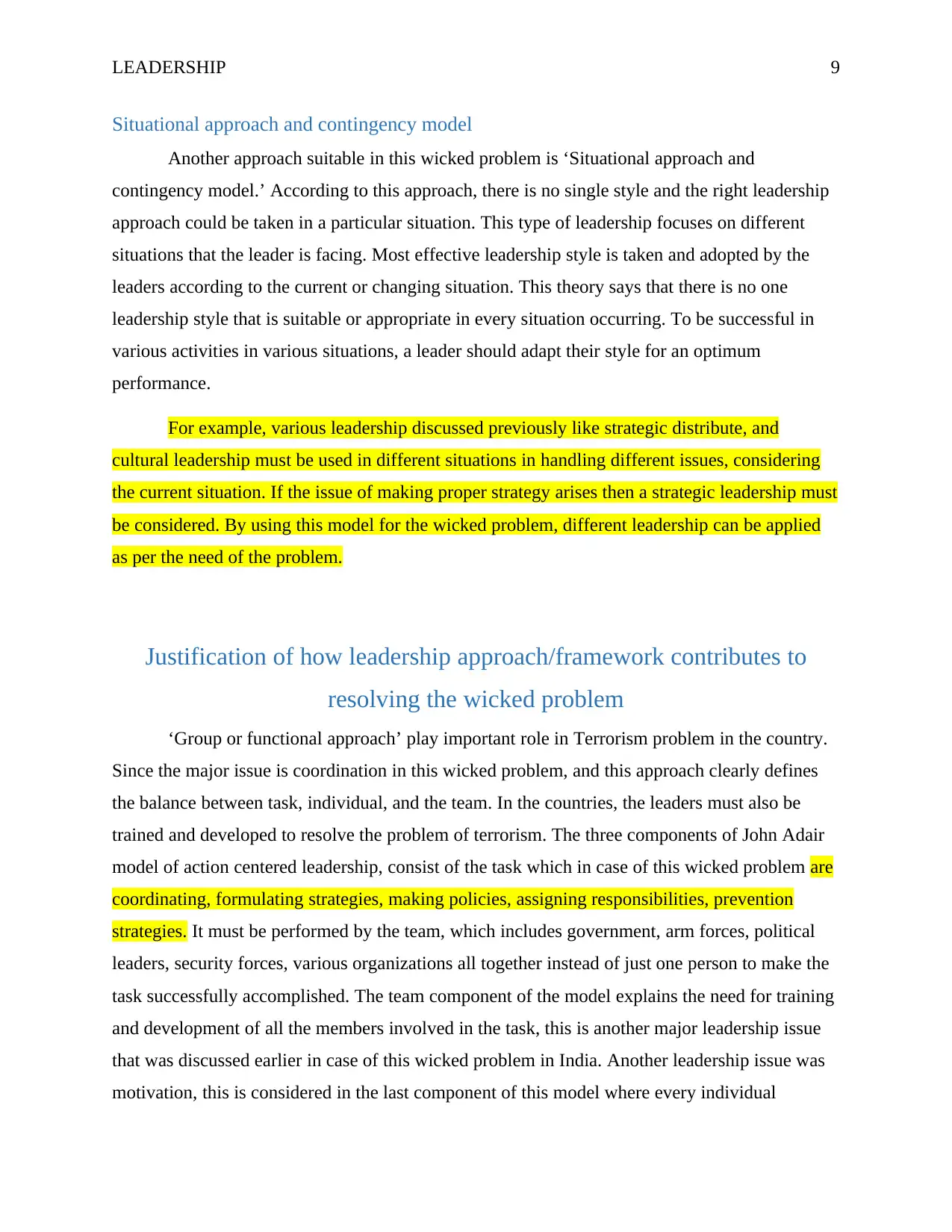
LEADERSHIP 9
Situational approach and contingency model
Another approach suitable in this wicked problem is ‘Situational approach and
contingency model.’ According to this approach, there is no single style and the right leadership
approach could be taken in a particular situation. This type of leadership focuses on different
situations that the leader is facing. Most effective leadership style is taken and adopted by the
leaders according to the current or changing situation. This theory says that there is no one
leadership style that is suitable or appropriate in every situation occurring. To be successful in
various activities in various situations, a leader should adapt their style for an optimum
performance.
For example, various leadership discussed previously like strategic distribute, and
cultural leadership must be used in different situations in handling different issues, considering
the current situation. If the issue of making proper strategy arises then a strategic leadership must
be considered. By using this model for the wicked problem, different leadership can be applied
as per the need of the problem.
Justification of how leadership approach/framework contributes to
resolving the wicked problem
‘Group or functional approach’ play important role in Terrorism problem in the country.
Since the major issue is coordination in this wicked problem, and this approach clearly defines
the balance between task, individual, and the team. In the countries, the leaders must also be
trained and developed to resolve the problem of terrorism. The three components of John Adair
model of action centered leadership, consist of the task which in case of this wicked problem are
coordinating, formulating strategies, making policies, assigning responsibilities, prevention
strategies. It must be performed by the team, which includes government, arm forces, political
leaders, security forces, various organizations all together instead of just one person to make the
task successfully accomplished. The team component of the model explains the need for training
and development of all the members involved in the task, this is another major leadership issue
that was discussed earlier in case of this wicked problem in India. Another leadership issue was
motivation, this is considered in the last component of this model where every individual
Situational approach and contingency model
Another approach suitable in this wicked problem is ‘Situational approach and
contingency model.’ According to this approach, there is no single style and the right leadership
approach could be taken in a particular situation. This type of leadership focuses on different
situations that the leader is facing. Most effective leadership style is taken and adopted by the
leaders according to the current or changing situation. This theory says that there is no one
leadership style that is suitable or appropriate in every situation occurring. To be successful in
various activities in various situations, a leader should adapt their style for an optimum
performance.
For example, various leadership discussed previously like strategic distribute, and
cultural leadership must be used in different situations in handling different issues, considering
the current situation. If the issue of making proper strategy arises then a strategic leadership must
be considered. By using this model for the wicked problem, different leadership can be applied
as per the need of the problem.
Justification of how leadership approach/framework contributes to
resolving the wicked problem
‘Group or functional approach’ play important role in Terrorism problem in the country.
Since the major issue is coordination in this wicked problem, and this approach clearly defines
the balance between task, individual, and the team. In the countries, the leaders must also be
trained and developed to resolve the problem of terrorism. The three components of John Adair
model of action centered leadership, consist of the task which in case of this wicked problem are
coordinating, formulating strategies, making policies, assigning responsibilities, prevention
strategies. It must be performed by the team, which includes government, arm forces, political
leaders, security forces, various organizations all together instead of just one person to make the
task successfully accomplished. The team component of the model explains the need for training
and development of all the members involved in the task, this is another major leadership issue
that was discussed earlier in case of this wicked problem in India. Another leadership issue was
motivation, this is considered in the last component of this model where every individual
Secure Best Marks with AI Grader
Need help grading? Try our AI Grader for instant feedback on your assignments.
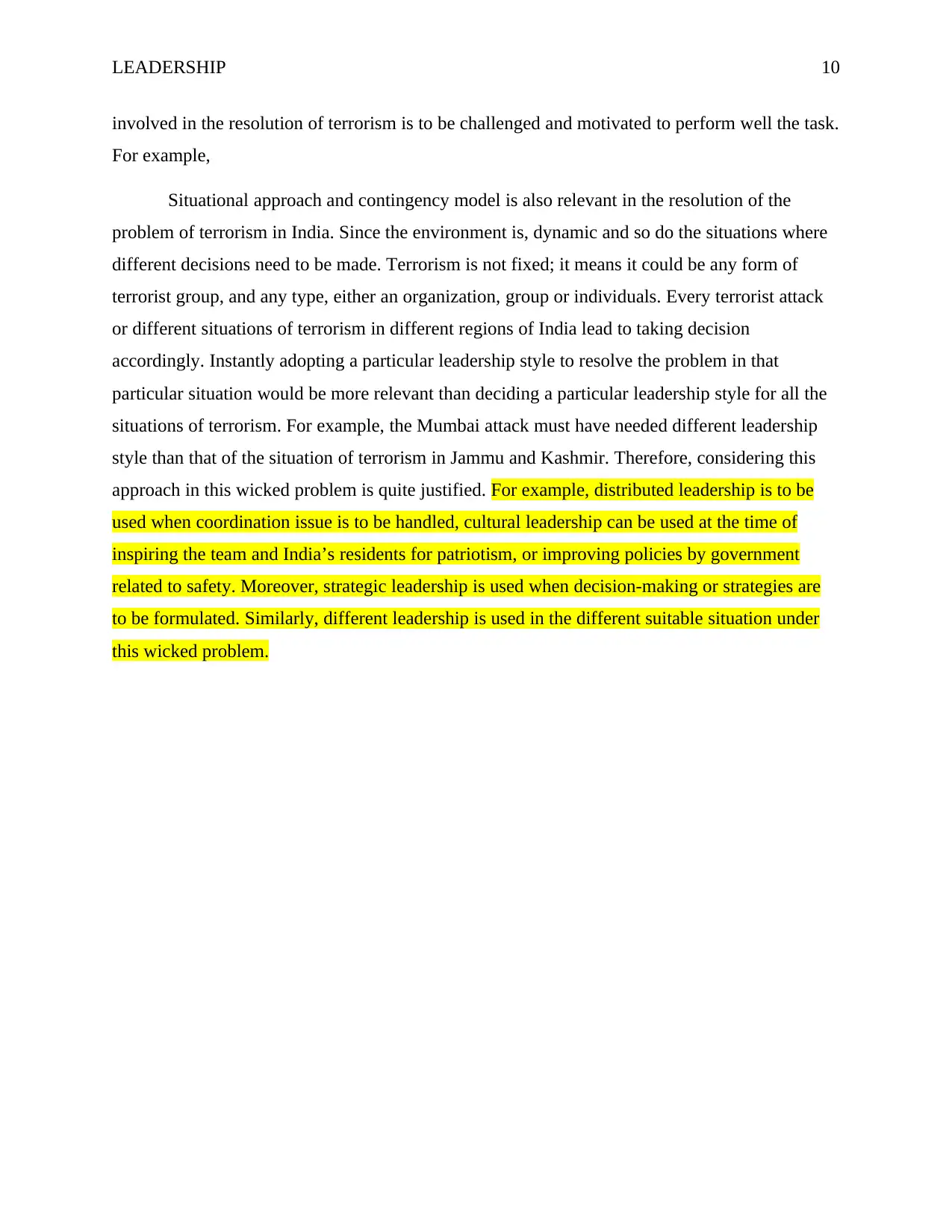
LEADERSHIP 10
involved in the resolution of terrorism is to be challenged and motivated to perform well the task.
For example,
Situational approach and contingency model is also relevant in the resolution of the
problem of terrorism in India. Since the environment is, dynamic and so do the situations where
different decisions need to be made. Terrorism is not fixed; it means it could be any form of
terrorist group, and any type, either an organization, group or individuals. Every terrorist attack
or different situations of terrorism in different regions of India lead to taking decision
accordingly. Instantly adopting a particular leadership style to resolve the problem in that
particular situation would be more relevant than deciding a particular leadership style for all the
situations of terrorism. For example, the Mumbai attack must have needed different leadership
style than that of the situation of terrorism in Jammu and Kashmir. Therefore, considering this
approach in this wicked problem is quite justified. For example, distributed leadership is to be
used when coordination issue is to be handled, cultural leadership can be used at the time of
inspiring the team and India’s residents for patriotism, or improving policies by government
related to safety. Moreover, strategic leadership is used when decision-making or strategies are
to be formulated. Similarly, different leadership is used in the different suitable situation under
this wicked problem.
involved in the resolution of terrorism is to be challenged and motivated to perform well the task.
For example,
Situational approach and contingency model is also relevant in the resolution of the
problem of terrorism in India. Since the environment is, dynamic and so do the situations where
different decisions need to be made. Terrorism is not fixed; it means it could be any form of
terrorist group, and any type, either an organization, group or individuals. Every terrorist attack
or different situations of terrorism in different regions of India lead to taking decision
accordingly. Instantly adopting a particular leadership style to resolve the problem in that
particular situation would be more relevant than deciding a particular leadership style for all the
situations of terrorism. For example, the Mumbai attack must have needed different leadership
style than that of the situation of terrorism in Jammu and Kashmir. Therefore, considering this
approach in this wicked problem is quite justified. For example, distributed leadership is to be
used when coordination issue is to be handled, cultural leadership can be used at the time of
inspiring the team and India’s residents for patriotism, or improving policies by government
related to safety. Moreover, strategic leadership is used when decision-making or strategies are
to be formulated. Similarly, different leadership is used in the different suitable situation under
this wicked problem.
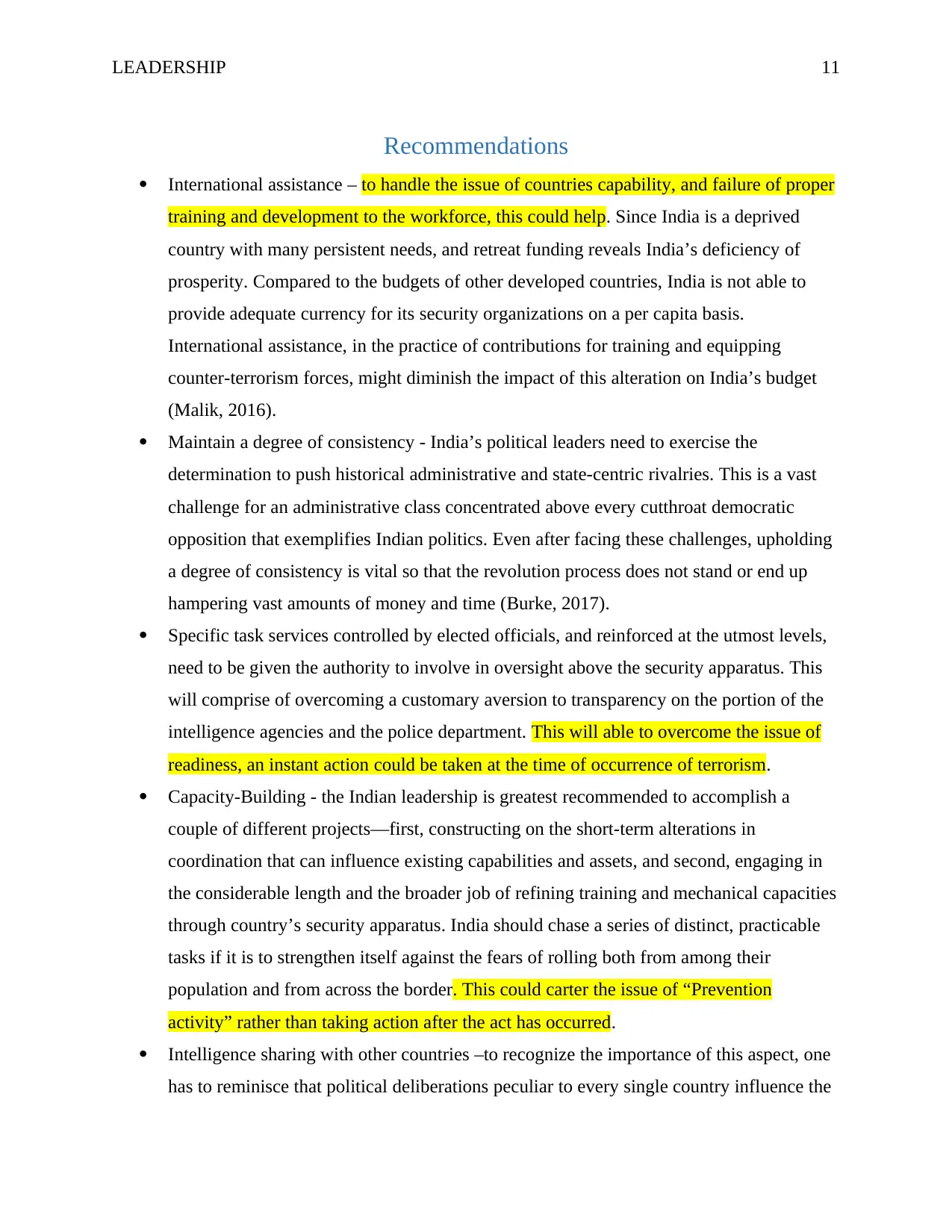
LEADERSHIP 11
Recommendations
International assistance – to handle the issue of countries capability, and failure of proper
training and development to the workforce, this could help. Since India is a deprived
country with many persistent needs, and retreat funding reveals India’s deficiency of
prosperity. Compared to the budgets of other developed countries, India is not able to
provide adequate currency for its security organizations on a per capita basis.
International assistance, in the practice of contributions for training and equipping
counter-terrorism forces, might diminish the impact of this alteration on India’s budget
(Malik, 2016).
Maintain a degree of consistency - India’s political leaders need to exercise the
determination to push historical administrative and state-centric rivalries. This is a vast
challenge for an administrative class concentrated above every cutthroat democratic
opposition that exemplifies Indian politics. Even after facing these challenges, upholding
a degree of consistency is vital so that the revolution process does not stand or end up
hampering vast amounts of money and time (Burke, 2017).
Specific task services controlled by elected officials, and reinforced at the utmost levels,
need to be given the authority to involve in oversight above the security apparatus. This
will comprise of overcoming a customary aversion to transparency on the portion of the
intelligence agencies and the police department. This will able to overcome the issue of
readiness, an instant action could be taken at the time of occurrence of terrorism.
Capacity-Building - the Indian leadership is greatest recommended to accomplish a
couple of different projects—first, constructing on the short-term alterations in
coordination that can influence existing capabilities and assets, and second, engaging in
the considerable length and the broader job of refining training and mechanical capacities
through country’s security apparatus. India should chase a series of distinct, practicable
tasks if it is to strengthen itself against the fears of rolling both from among their
population and from across the border. This could carter the issue of “Prevention
activity” rather than taking action after the act has occurred.
Intelligence sharing with other countries –to recognize the importance of this aspect, one
has to reminisce that political deliberations peculiar to every single country influence the
Recommendations
International assistance – to handle the issue of countries capability, and failure of proper
training and development to the workforce, this could help. Since India is a deprived
country with many persistent needs, and retreat funding reveals India’s deficiency of
prosperity. Compared to the budgets of other developed countries, India is not able to
provide adequate currency for its security organizations on a per capita basis.
International assistance, in the practice of contributions for training and equipping
counter-terrorism forces, might diminish the impact of this alteration on India’s budget
(Malik, 2016).
Maintain a degree of consistency - India’s political leaders need to exercise the
determination to push historical administrative and state-centric rivalries. This is a vast
challenge for an administrative class concentrated above every cutthroat democratic
opposition that exemplifies Indian politics. Even after facing these challenges, upholding
a degree of consistency is vital so that the revolution process does not stand or end up
hampering vast amounts of money and time (Burke, 2017).
Specific task services controlled by elected officials, and reinforced at the utmost levels,
need to be given the authority to involve in oversight above the security apparatus. This
will comprise of overcoming a customary aversion to transparency on the portion of the
intelligence agencies and the police department. This will able to overcome the issue of
readiness, an instant action could be taken at the time of occurrence of terrorism.
Capacity-Building - the Indian leadership is greatest recommended to accomplish a
couple of different projects—first, constructing on the short-term alterations in
coordination that can influence existing capabilities and assets, and second, engaging in
the considerable length and the broader job of refining training and mechanical capacities
through country’s security apparatus. India should chase a series of distinct, practicable
tasks if it is to strengthen itself against the fears of rolling both from among their
population and from across the border. This could carter the issue of “Prevention
activity” rather than taking action after the act has occurred.
Intelligence sharing with other countries –to recognize the importance of this aspect, one
has to reminisce that political deliberations peculiar to every single country influence the
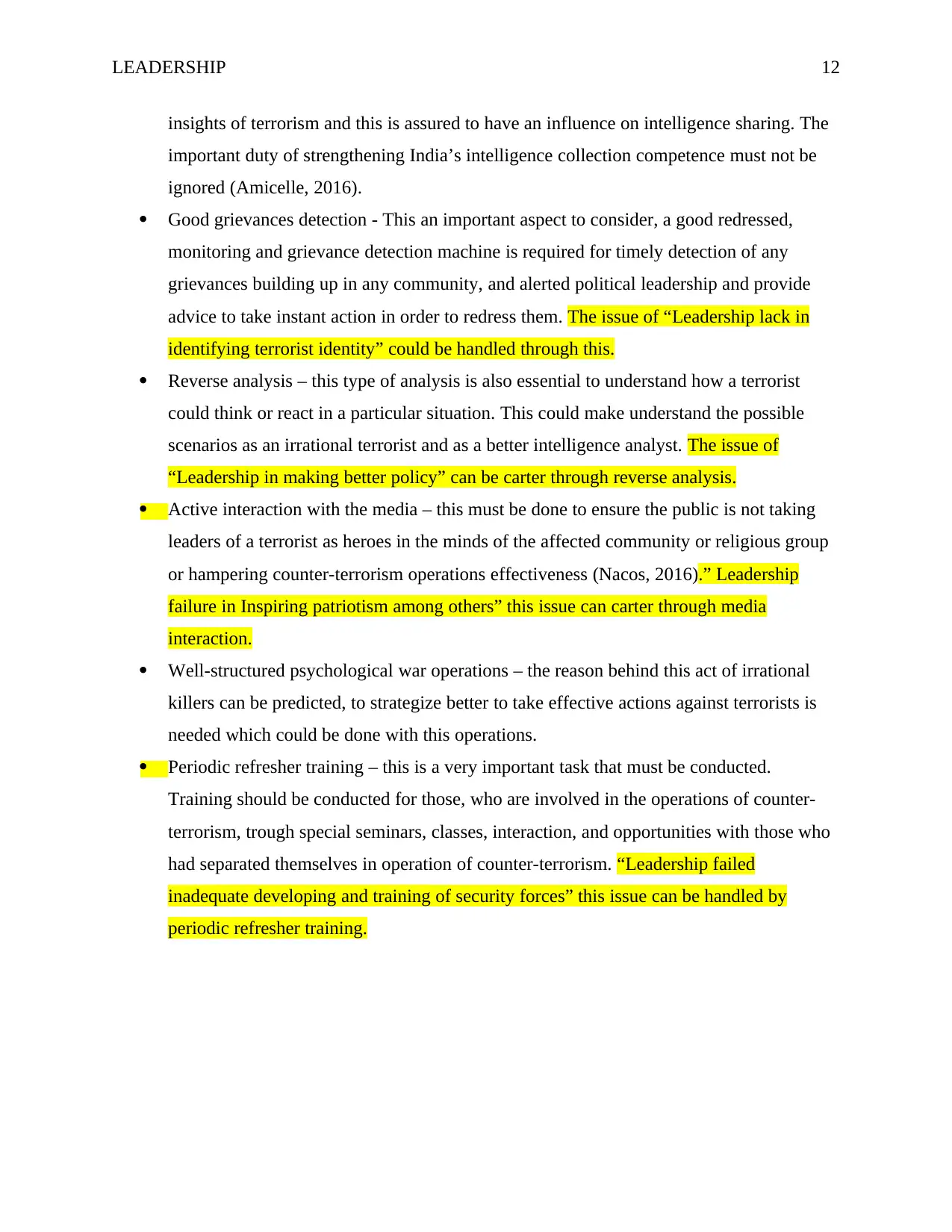
LEADERSHIP 12
insights of terrorism and this is assured to have an influence on intelligence sharing. The
important duty of strengthening India’s intelligence collection competence must not be
ignored (Amicelle, 2016).
Good grievances detection - This an important aspect to consider, a good redressed,
monitoring and grievance detection machine is required for timely detection of any
grievances building up in any community, and alerted political leadership and provide
advice to take instant action in order to redress them. The issue of “Leadership lack in
identifying terrorist identity” could be handled through this.
Reverse analysis – this type of analysis is also essential to understand how a terrorist
could think or react in a particular situation. This could make understand the possible
scenarios as an irrational terrorist and as a better intelligence analyst. The issue of
“Leadership in making better policy” can be carter through reverse analysis.
Active interaction with the media – this must be done to ensure the public is not taking
leaders of a terrorist as heroes in the minds of the affected community or religious group
or hampering counter-terrorism operations effectiveness (Nacos, 2016).” Leadership
failure in Inspiring patriotism among others” this issue can carter through media
interaction.
Well-structured psychological war operations – the reason behind this act of irrational
killers can be predicted, to strategize better to take effective actions against terrorists is
needed which could be done with this operations.
Periodic refresher training – this is a very important task that must be conducted.
Training should be conducted for those, who are involved in the operations of counter-
terrorism, trough special seminars, classes, interaction, and opportunities with those who
had separated themselves in operation of counter-terrorism. “Leadership failed
inadequate developing and training of security forces” this issue can be handled by
periodic refresher training.
insights of terrorism and this is assured to have an influence on intelligence sharing. The
important duty of strengthening India’s intelligence collection competence must not be
ignored (Amicelle, 2016).
Good grievances detection - This an important aspect to consider, a good redressed,
monitoring and grievance detection machine is required for timely detection of any
grievances building up in any community, and alerted political leadership and provide
advice to take instant action in order to redress them. The issue of “Leadership lack in
identifying terrorist identity” could be handled through this.
Reverse analysis – this type of analysis is also essential to understand how a terrorist
could think or react in a particular situation. This could make understand the possible
scenarios as an irrational terrorist and as a better intelligence analyst. The issue of
“Leadership in making better policy” can be carter through reverse analysis.
Active interaction with the media – this must be done to ensure the public is not taking
leaders of a terrorist as heroes in the minds of the affected community or religious group
or hampering counter-terrorism operations effectiveness (Nacos, 2016).” Leadership
failure in Inspiring patriotism among others” this issue can carter through media
interaction.
Well-structured psychological war operations – the reason behind this act of irrational
killers can be predicted, to strategize better to take effective actions against terrorists is
needed which could be done with this operations.
Periodic refresher training – this is a very important task that must be conducted.
Training should be conducted for those, who are involved in the operations of counter-
terrorism, trough special seminars, classes, interaction, and opportunities with those who
had separated themselves in operation of counter-terrorism. “Leadership failed
inadequate developing and training of security forces” this issue can be handled by
periodic refresher training.
Paraphrase This Document
Need a fresh take? Get an instant paraphrase of this document with our AI Paraphraser
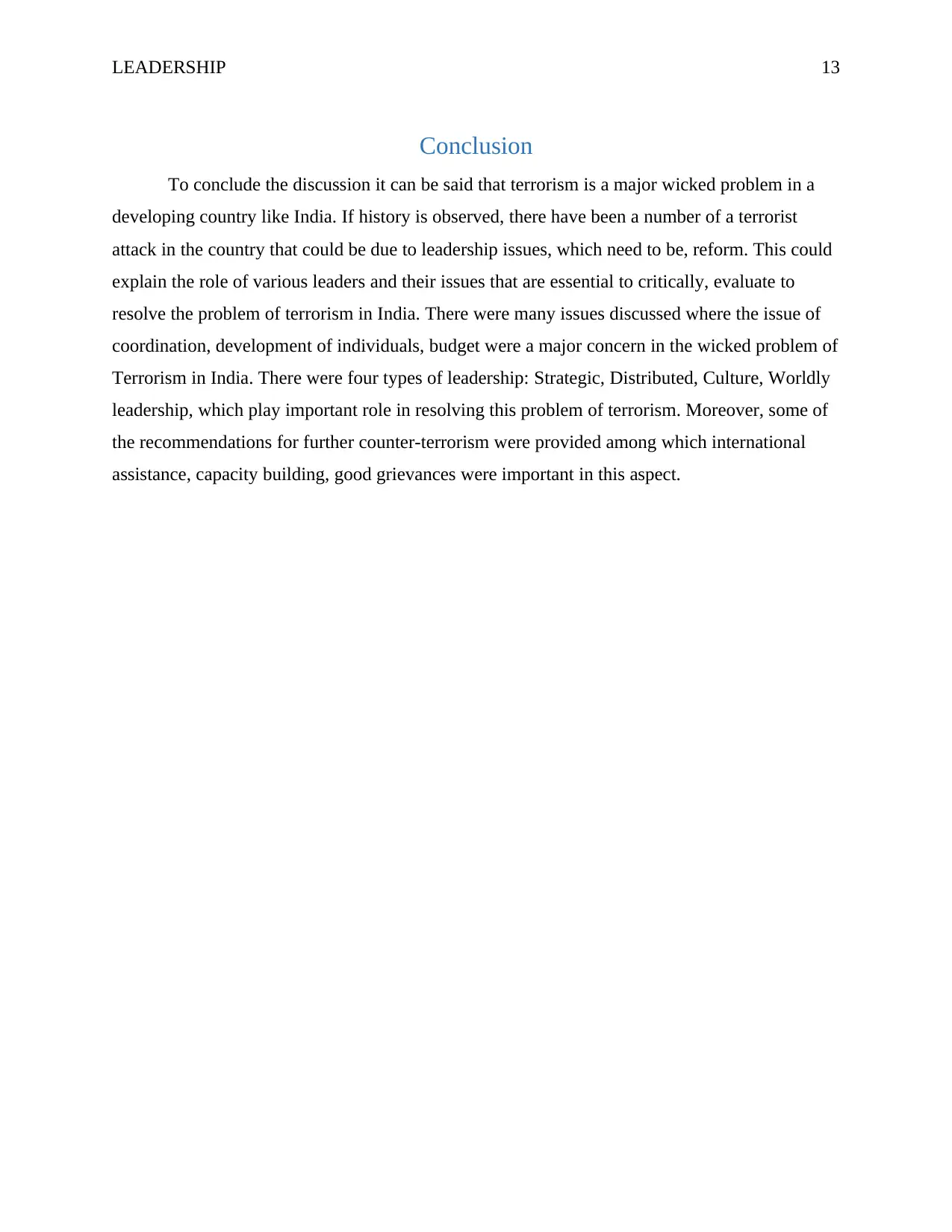
LEADERSHIP 13
Conclusion
To conclude the discussion it can be said that terrorism is a major wicked problem in a
developing country like India. If history is observed, there have been a number of a terrorist
attack in the country that could be due to leadership issues, which need to be, reform. This could
explain the role of various leaders and their issues that are essential to critically, evaluate to
resolve the problem of terrorism in India. There were many issues discussed where the issue of
coordination, development of individuals, budget were a major concern in the wicked problem of
Terrorism in India. There were four types of leadership: Strategic, Distributed, Culture, Worldly
leadership, which play important role in resolving this problem of terrorism. Moreover, some of
the recommendations for further counter-terrorism were provided among which international
assistance, capacity building, good grievances were important in this aspect.
Conclusion
To conclude the discussion it can be said that terrorism is a major wicked problem in a
developing country like India. If history is observed, there have been a number of a terrorist
attack in the country that could be due to leadership issues, which need to be, reform. This could
explain the role of various leaders and their issues that are essential to critically, evaluate to
resolve the problem of terrorism in India. There were many issues discussed where the issue of
coordination, development of individuals, budget were a major concern in the wicked problem of
Terrorism in India. There were four types of leadership: Strategic, Distributed, Culture, Worldly
leadership, which play important role in resolving this problem of terrorism. Moreover, some of
the recommendations for further counter-terrorism were provided among which international
assistance, capacity building, good grievances were important in this aspect.
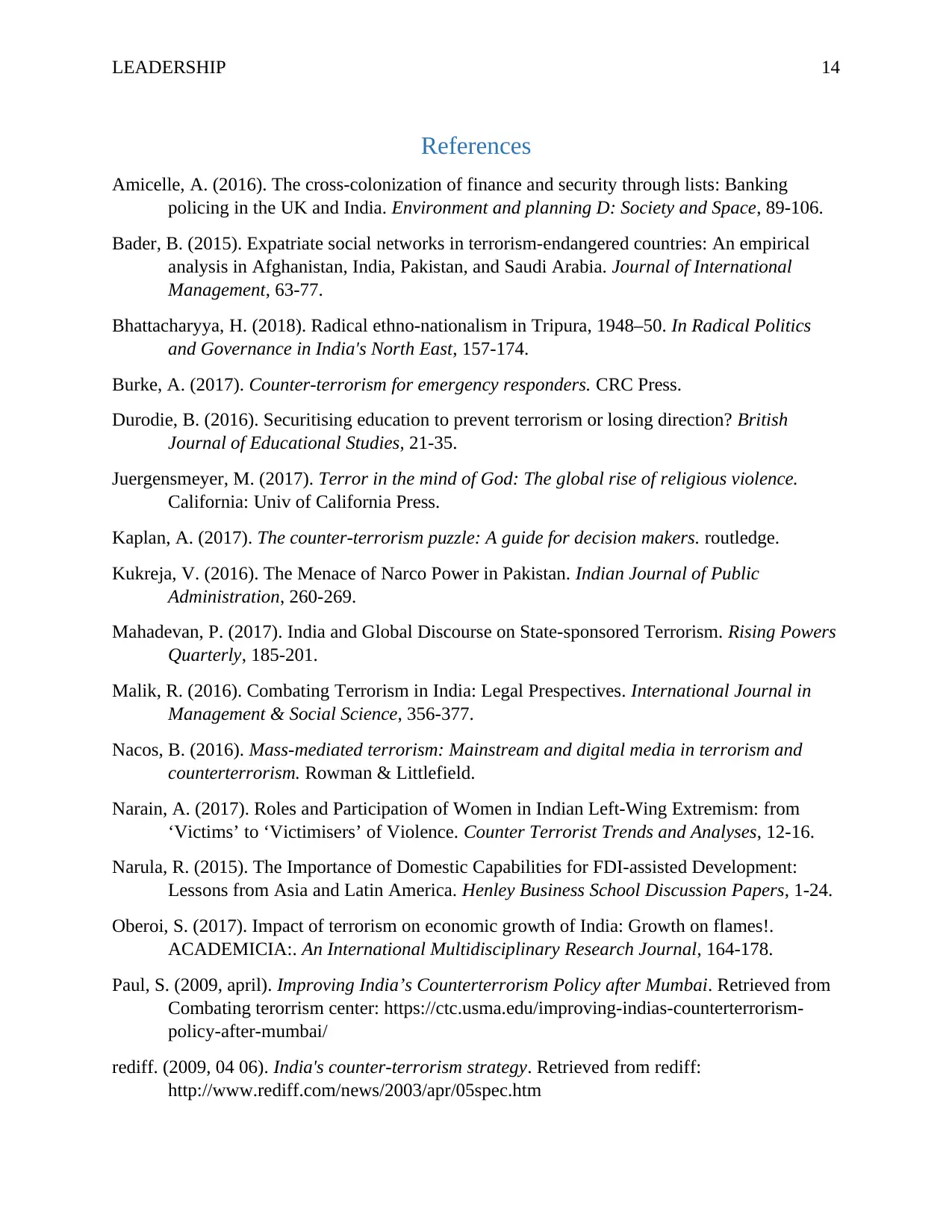
LEADERSHIP 14
References
Amicelle, A. (2016). The cross-colonization of finance and security through lists: Banking
policing in the UK and India. Environment and planning D: Society and Space, 89-106.
Bader, B. (2015). Expatriate social networks in terrorism-endangered countries: An empirical
analysis in Afghanistan, India, Pakistan, and Saudi Arabia. Journal of International
Management, 63-77.
Bhattacharyya, H. (2018). Radical ethno-nationalism in Tripura, 1948–50. In Radical Politics
and Governance in India's North East, 157-174.
Burke, A. (2017). Counter-terrorism for emergency responders. CRC Press.
Durodie, B. (2016). Securitising education to prevent terrorism or losing direction? British
Journal of Educational Studies, 21-35.
Juergensmeyer, M. (2017). Terror in the mind of God: The global rise of religious violence.
California: Univ of California Press.
Kaplan, A. (2017). The counter-terrorism puzzle: A guide for decision makers. routledge.
Kukreja, V. (2016). The Menace of Narco Power in Pakistan. Indian Journal of Public
Administration, 260-269.
Mahadevan, P. (2017). India and Global Discourse on State-sponsored Terrorism. Rising Powers
Quarterly, 185-201.
Malik, R. (2016). Combating Terrorism in India: Legal Prespectives. International Journal in
Management & Social Science, 356-377.
Nacos, B. (2016). Mass-mediated terrorism: Mainstream and digital media in terrorism and
counterterrorism. Rowman & Littlefield.
Narain, A. (2017). Roles and Participation of Women in Indian Left-Wing Extremism: from
‘Victims’ to ‘Victimisers’ of Violence. Counter Terrorist Trends and Analyses, 12-16.
Narula, R. (2015). The Importance of Domestic Capabilities for FDI-assisted Development:
Lessons from Asia and Latin America. Henley Business School Discussion Papers, 1-24.
Oberoi, S. (2017). Impact of terrorism on economic growth of India: Growth on flames!.
ACADEMICIA:. An International Multidisciplinary Research Journal, 164-178.
Paul, S. (2009, april). Improving India’s Counterterrorism Policy after Mumbai. Retrieved from
Combating terorrism center: https://ctc.usma.edu/improving-indias-counterterrorism-
policy-after-mumbai/
rediff. (2009, 04 06). India's counter-terrorism strategy. Retrieved from rediff:
http://www.rediff.com/news/2003/apr/05spec.htm
References
Amicelle, A. (2016). The cross-colonization of finance and security through lists: Banking
policing in the UK and India. Environment and planning D: Society and Space, 89-106.
Bader, B. (2015). Expatriate social networks in terrorism-endangered countries: An empirical
analysis in Afghanistan, India, Pakistan, and Saudi Arabia. Journal of International
Management, 63-77.
Bhattacharyya, H. (2018). Radical ethno-nationalism in Tripura, 1948–50. In Radical Politics
and Governance in India's North East, 157-174.
Burke, A. (2017). Counter-terrorism for emergency responders. CRC Press.
Durodie, B. (2016). Securitising education to prevent terrorism or losing direction? British
Journal of Educational Studies, 21-35.
Juergensmeyer, M. (2017). Terror in the mind of God: The global rise of religious violence.
California: Univ of California Press.
Kaplan, A. (2017). The counter-terrorism puzzle: A guide for decision makers. routledge.
Kukreja, V. (2016). The Menace of Narco Power in Pakistan. Indian Journal of Public
Administration, 260-269.
Mahadevan, P. (2017). India and Global Discourse on State-sponsored Terrorism. Rising Powers
Quarterly, 185-201.
Malik, R. (2016). Combating Terrorism in India: Legal Prespectives. International Journal in
Management & Social Science, 356-377.
Nacos, B. (2016). Mass-mediated terrorism: Mainstream and digital media in terrorism and
counterterrorism. Rowman & Littlefield.
Narain, A. (2017). Roles and Participation of Women in Indian Left-Wing Extremism: from
‘Victims’ to ‘Victimisers’ of Violence. Counter Terrorist Trends and Analyses, 12-16.
Narula, R. (2015). The Importance of Domestic Capabilities for FDI-assisted Development:
Lessons from Asia and Latin America. Henley Business School Discussion Papers, 1-24.
Oberoi, S. (2017). Impact of terrorism on economic growth of India: Growth on flames!.
ACADEMICIA:. An International Multidisciplinary Research Journal, 164-178.
Paul, S. (2009, april). Improving India’s Counterterrorism Policy after Mumbai. Retrieved from
Combating terorrism center: https://ctc.usma.edu/improving-indias-counterterrorism-
policy-after-mumbai/
rediff. (2009, 04 06). India's counter-terrorism strategy. Retrieved from rediff:
http://www.rediff.com/news/2003/apr/05spec.htm
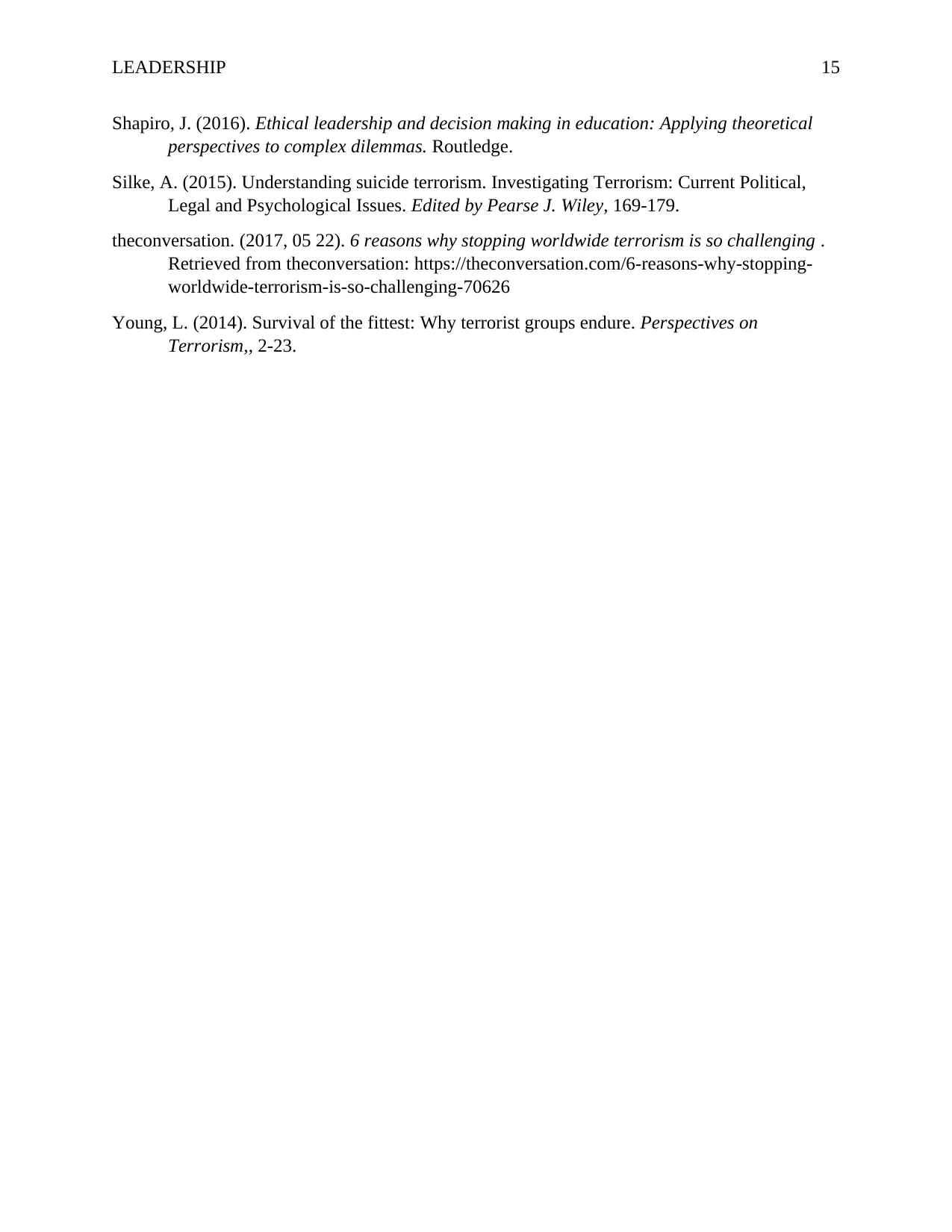
LEADERSHIP 15
Shapiro, J. (2016). Ethical leadership and decision making in education: Applying theoretical
perspectives to complex dilemmas. Routledge.
Silke, A. (2015). Understanding suicide terrorism. Investigating Terrorism: Current Political,
Legal and Psychological Issues. Edited by Pearse J. Wiley, 169-179.
theconversation. (2017, 05 22). 6 reasons why stopping worldwide terrorism is so challenging .
Retrieved from theconversation: https://theconversation.com/6-reasons-why-stopping-
worldwide-terrorism-is-so-challenging-70626
Young, L. (2014). Survival of the fittest: Why terrorist groups endure. Perspectives on
Terrorism,, 2-23.
Shapiro, J. (2016). Ethical leadership and decision making in education: Applying theoretical
perspectives to complex dilemmas. Routledge.
Silke, A. (2015). Understanding suicide terrorism. Investigating Terrorism: Current Political,
Legal and Psychological Issues. Edited by Pearse J. Wiley, 169-179.
theconversation. (2017, 05 22). 6 reasons why stopping worldwide terrorism is so challenging .
Retrieved from theconversation: https://theconversation.com/6-reasons-why-stopping-
worldwide-terrorism-is-so-challenging-70626
Young, L. (2014). Survival of the fittest: Why terrorist groups endure. Perspectives on
Terrorism,, 2-23.
1 out of 16
Your All-in-One AI-Powered Toolkit for Academic Success.
+13062052269
info@desklib.com
Available 24*7 on WhatsApp / Email
![[object Object]](/_next/static/media/star-bottom.7253800d.svg)
Unlock your academic potential
© 2024 | Zucol Services PVT LTD | All rights reserved.
